Potential Molecular Mimicry Proteins Responsive to α-pinene in Bursaphelenchus xylophilus
Abstract
1. Introduction
2. Results
2.1. Cloning of Bx-tlp-2 and Bx-cpi
2.2. Analysis of the Bx-TLP-2 and Bx-CPI Proteins
2.3. Genetic Relationship between Bx-tlp-2 and Bx-cpi
2.4. Expression of Bx-tlp-1, Bx-tlp-2, Bx-cpi and Bx-cpl-1
2.5. Expression Patterns of Potential Molecular Mimicry Proteins from B. xylophilus and P. massoniana
3. Discussion
4. Materials and Methods
4.1. Materials
4.2. RNA Isolation and cDNA Cloning
4.3. Verification of the Relationship between α-pinene and the Potential Molecular Mimicry Proteins in Bursaphelenchus xylophilus
4.4. Expression Analysis of the Potential Molecular Mimicry Proteins from Bursaphelenchus xylophilus and Pinus massoniana
4.5. Data Analysis
Supplementary Materials
Author Contributions
Funding
Conflicts of Interest
References
- Nickle, W.R.; Golden, A.M.; Mamiya, Y.; Wergin, W.P. On the taxonomy and morphology of the pine wood nematode, Bursaphelenchus xylophilus (Steiner &Buhrer 1934) Nickle 1970. J. Nematol. 1981, 13, 385–392. [Google Scholar] [PubMed]
- Mamiya, Y. History of pine wilt disease in Japan. J. Nematol. 1988, 20, 219–226. [Google Scholar] [PubMed]
- Togashi, K.; Shigesada, N. Spread of the pinewood nematode vectored by the Japanese pine sawyer: Modeling and analytical approaches. Popul. Ecol. 2006, 48, 271–283. [Google Scholar] [CrossRef]
- Yoshimura, A.; Kawasaki, K.; Takasu, F.; Togashi, K.; Futai, K.; Shigesada, N. Modeling the spread of pine wilt disease caused by nematodes with pine sawyers as vector. Ecology 1999, 80, 1691–1702. [Google Scholar] [CrossRef]
- Abelleira, A.; Picoaga, A.; Mansilla, J.P.; Aguin, O. Detection of Bursaphelenchus xylophilus, causal agent of pine wilt disease on Pinus pinaster in northwestern Spain. Plant Dis. 2011, 95, 776. [Google Scholar] [CrossRef] [PubMed]
- Branco, M.; Bragança, H.; Sousa, E.; Phillips, A.J. Pests and diseases in Portuguese forestry: Current and new threats. In Forest Context and Policies in Portugal; Reboredo, F., Ed.; Springer: Cham, Switzerland, 2014; Chapter 5; pp. 126–129. [Google Scholar]
- Mota, M.; Oliveira, S.; Vicente, C.; Vieira, P. Pine wilt disease in portugal: Recent progress and new approaches to the understanding and control of the pinewood nematode and its insect vector. J. Nematol. 2009, 41, 361. [Google Scholar]
- Vicente, C.; Espada, M.; Vieira, P.; Mota, M. Pine wilt disease: A threat to European forestry. Eur. J. Plant Pathol. 2012, 133, 497. [Google Scholar] [CrossRef]
- Sun, Y. Pine wood nematode found at Dr. Sun Yat’s Mausoleum in Nanjing. Jiangsu For. Sci. Technol. 1982, 4, 47. [Google Scholar]
- Kiyohara, T.; Tokushige, Y. Inoculation experiments of a nematode, Bursaphelenchus sp., onto pine trees. J. Jpn. For. Soc. 1971, 53, 210–218. [Google Scholar]
- Mamiya, Y.; Enda, N. Transmission of Bursaphelenchus lignicolus (Nematoda: Aphelenchoididae) by Monochamus alternatus (Coleoptera: Cerambycidae). Nematologica 1972, 18, 159–162. [Google Scholar] [CrossRef]
- Mota, M.M.; Braasch, H.; Bravo, M.A.; Penas, A.C.; Burgermeister, W.; Kai, M.; Sousa, E. First report of Bursaphelenchus xylophilus in Portugal and in Europe. Nematology 1999, 1, 727–734. [Google Scholar]
- Lewinsohn, E.; Savage, T.J.; Croteau, R. Simultaneous analysis of monoterpenes and diterpenoids of conifer oleoresin. Phytochem. Anal. 2010, 4, 220–225. [Google Scholar] [CrossRef]
- Zulak, K.G.; Bohlmann, J. Terpenoid biosynthesis and specialized vascular cells of conifer defense. J. Integr. Plant Biol. 2010, 52, 86–97. [Google Scholar] [CrossRef]
- Ning, T.; Fan, J.; Fang, Y.; Sun, J. Changes in contents of host volatile terpenes under different damaged states and electroantennogram response of Monochamus alternatus Hope to these volatiles. Acta Entomol. Sin. 2006, 49, 179–188. [Google Scholar]
- Futai, K. Pine wood nematode, Bursaphelenchus xylophilus. Annu. Rev. Phytopathol. 2013, 51, 61–83. [Google Scholar] [CrossRef] [PubMed]
- Niu, H.; Zhao, L.; Lu, M.; Zhang, S.; Sun, J. The ratio and concentration of two monoterpenes mediate fecundity of the pinewood nematode and growth of its associated fungi. PLoS ONE 2012, 7, e31716. [Google Scholar] [CrossRef] [PubMed]
- Zhao, L.L.; Wei, W.; Kang, L.; Sun, J.H. Chemotaxis of the pinewood nematode, Bursaphelenchus xylophilus, to volatiles associated with host pine, Pinus massoniana, and its vector Monochamus alternatus. J. Chem. Ecol. 2007, 33, 1207–1216. [Google Scholar] [CrossRef] [PubMed]
- Zhao, Z.D.; Hu, X.E.; Li, D.M.; Xu, F.Y.; Hu, G.X.; Sun, Z.; Liu, X.Z. Study on chemical components and resistance mechanism to pine wood nematode of masson pine provenance (III) Study on contents variation of neutral terpenoids of resistant provenance of P. massoniana after inoculating Bursaphelenchus xylophilus. Chem. Ind. For. Prod. 2001, 21, 52–58. [Google Scholar]
- Kuroda, K.; Yamada, T.; Mineo, K.; Tamura, H. Effects of cavitation on the development of pine wilt disease caused by Bursaphelenchus xylophilus. Ann. Phytopathol. Soc. Jpn. 1988, 54, 606–615. [Google Scholar] [CrossRef]
- Kikuchi, T.; Cotton, J.A.; Dalzell, J.J.; Hasegawa, K.; Kanzaki, N.; Mcveigh, P.; Takanashi, T.; Tsai, I.J.; Assefa, S.A.; Cock, P.J.A. Genomic insights into the origin of parasitism in the emerging plant pathogen Bursaphelenchus xylophilus. PLoS Pathog. 2011, 7, e1002219. [Google Scholar] [CrossRef]
- Li, Y.X.; Meng, F.L.; Deng, X.; Wang, X.; Feng, Y.Q.; Zhang, W.; Pan, L.; Zhang, X.Y. Comparative transcriptome analysis of the pinewood nematode Bursaphelenchus xylophilus reveals the molecular mechanism underlying its defense response to host-derived α-pinene. Int. J. Mol. Sci. 2019, 20, 911. [Google Scholar] [CrossRef] [PubMed]
- Ryoji, S.; Hironobu, M.; Taisei, K.; Yuko, T.; Mitsuyoshi, U.; Kazuyoshi, F. Secretome analysis of the pine wood nematode Bursaphelenchus xylophilus reveals the tangled roots of parasitism and its potential for molecular mimicry. PLoS ONE 2013, 8, e67377. [Google Scholar]
- Hoffmann-Sommergruber, K. Pathogenesis-related (PR)-proteins identified as allergens. Biochem. Soc. Trans. 2002, 30, 930–935. [Google Scholar] [CrossRef] [PubMed]
- Kitajima, S.; Sato, F. Plant pathogenesis-related proteins: Molecular mechanisms of gene expression and protein function. J. Biochem. 1999, 125, 1–8. [Google Scholar] [CrossRef] [PubMed]
- Maizels, R.M.; Yazdanbakhsh, M. Immune regulation by helminth parasites: Cellular and molecular mechanisms. Nat. Rev. Immunol. 2003, 3, 733–744. [Google Scholar] [CrossRef] [PubMed]
- Falcone, F.H.; Loke, P.; Zang, X.; Macdonald, A.S.; Maizels, R.M.; Allen, J.E. A Brugia malayi homolog of macrophage migration inhibitory factor reveals an important link between macrophages and eosinophil recruitment during nematode infection. J. Immunol. 2001, 167, 5348–5354. [Google Scholar] [CrossRef]
- Siddique, S.; Radakovic, Z.S.; Cm, D.L.T.; Chronis, D.; Novák, O.; Ramireddy, E.; Holbein, J.; Matera, C.; Hütten, M.; Gutbrod, P. A parasitic nematode releases cytokinin that controls cell division and orchestrates feeding site formation in host plants. PNAS 2015, 112, 12669–12674. [Google Scholar] [CrossRef]
- Wang, J.; Replogle, A.; Hussey, R.; Baum, T.; Wang, X.; Davis, E.L.; Mitchum, M.G. Identification of potential host plant mimics of CLAVATA3/ESR (CLE)-like peptides from the plant-parasitic nematode Heterodera schachtii. Mol. Plant Pathol. 2011, 12, 177–186. [Google Scholar] [CrossRef]
- Mitchum, M.G.; Wang, X.; Wang, J.; Davis, E.L. Role of nematode peptides and other small molecules in plant parasitism. Annu. Rev. Phytopathol. 2012, 50, 175–195. [Google Scholar] [CrossRef]
- Bellafiore, S.; Shen, Z.; Rosso, M.N.; Abad, P.; Shih, P.; Briggs, S.P. Direct identification of the Meloidogyne incognita secretome reveals proteins with host cell reprogramming potential. PLoS Pathog. 2008, 4, e1000192. [Google Scholar] [CrossRef]
- Wang, J.; Han, S.; Li, Y.; Deng, X.; Zhang, X. Cloning of TLP-1 gene and prediction of TLP-1 protein structure of Bursaphelenchus xylophilus. J. Sichuan Agri. Univ. 2014, 32, 305–310. [Google Scholar]
- Meng, F.L.; Wang, J.; Wang, X.; Li, Y.X.; Zhang, X.Y. Expression analysis of thaumatin-like proteins from Bursaphelenchus xylophilus and Pinus massoniana. Physiol. Mol. Plant Pathol. 2017, 100, 178–184. [Google Scholar] [CrossRef]
- Rosenthal, P.J. Cysteine proteases of malaria parasites. Int. J. Parasitol. 2004, 34, 1489–1499. [Google Scholar] [CrossRef] [PubMed]
- Urwin, P.E.; Lilley, C.J.; Mcpherson, M.J.; Atkinson, H.J. Characterization of two cDNAs encoding cysteine proteinases from the soybean cyst nematode Heterodera glycines. Parasitology 1997, 114, 605–613. [Google Scholar]
- Shingles, J.; Lilley, C.J.; Urwin, P.E. Meloidogyne incognita: Molecular and biochemical characterisation of a cathepsin L cysteine proteinase and the effect on parasitism following RNAi. Exp. Parasitol. 2007, 115, 114–120. [Google Scholar] [CrossRef]
- Britton, C.; Murray, L. Cathepsin L protease (CPL-1) is essential for yolk processing during embryogenesis in Caenorhabditis elegans. J. Cell Sci. 2004, 117, 5133–5143. [Google Scholar] [CrossRef]
- Hashmi, S.; Zhang, J.; Oksov, Y.; Lustigman, S. The Caenorhabditis elegans cathepsin Z-like cysteine protease, Ce-CPZ-1, has a multifunctional role during the worms’ development. J. Biol. Chem. 2004, 279, 6035–6045. [Google Scholar] [CrossRef]
- Ghoneim, H.; Klinkert, M.Q. Biochemical properties of purified cathepsin B from Schistosoma mansoni. Int. J. Parasitol. 1995, 25, 1515–1519. [Google Scholar] [CrossRef]
- Kamata, I.; Yamada, M.; Uchikawa, R.; Matsuda, S.; Arizono, N. Cysteine protease of the nematode Nippostrongylus brasiliensis preferentially evokes an IgE/IgG1 antibody response in rats. Clin. Exp. Immunol. 1995, 102, 71–77. [Google Scholar] [CrossRef]
- Bai, T. The function of the cathepsin L cysteine gene in early life history of pine wood nematode. Beijing Norm. Univ. 2011, 15–20. [Google Scholar]
- Xue, Q.; Wu, X.Q.; Zhang, W.J.; Deng, L.N.; Wu, M.M. Cathepsin L-like cysteine proteinase genes are associated with the development and pathogenicity of pine wood nematode, Bursaphelenchus xylophilus. Int. J. Mol. Sci. 2019, 20, 215. [Google Scholar] [CrossRef] [PubMed]
- Turk, V.; Bode, W. The cystatins: Protein inhibitors of cysteine proteinases. FEBS Lett. 1991, 285, 213–219. [Google Scholar] [CrossRef]
- Abrahamson, M.; Alvarez-Fernandez, M.; Nathanson, C.M. Cystatins. Biochem. Soc. Symp. 2003, 70, 179–199. [Google Scholar]
- Zhao, C.; Wu, D.; Yan, Y.; Li, Q. Analysis of masson pine needle volatiles and their electroantennogram activity with masson pine caterpillar. Sci. Silvae Sin. 1995, 31, 125–131. [Google Scholar]
- Olonen, A.K.N.; Paulin, L. A new type of cysteine proteinase inhibitor—the salarin gene from Atlantic salmon (Salmo salar L.) and Arctic charr (Salvelinus alpinus). Biochimie 2003, 85, 677–681. [Google Scholar] [CrossRef]
- Meng, F.L.; Li, Y.X.; Wang, X.; Feng, Y.Q.; Liu, Z.K.; Zhang, W.; Zhang, X.Y. Thaumatin-like protein-1 gene (Bx-tlp-1) is associated with the pathogenicity of Bursaphelenchus xylophilus. Phytopathology 2019, 109, 1949–1956. [Google Scholar] [CrossRef]
- Hirao, T.; Fukatsu, E.; Watanabe, A. Characterization of resistance to pine wood nematode infection in Pinus thunbergii using suppression subtractive hybridization. BMC Plant Biol. 2012, 12, 13. [Google Scholar] [CrossRef]
- Espada, M.; Ana, C.S.; Sebastian, E.A.; Peter, J.C.; Manuel, M.; John, T.J. Identification and characterization of parasitism genes from the pinewood nematode Bursaphelenchus xylophilus reveals a multilayered detoxification strategy. Mol. Plant Pathol. 2016, 17, 286–295. [Google Scholar] [CrossRef]
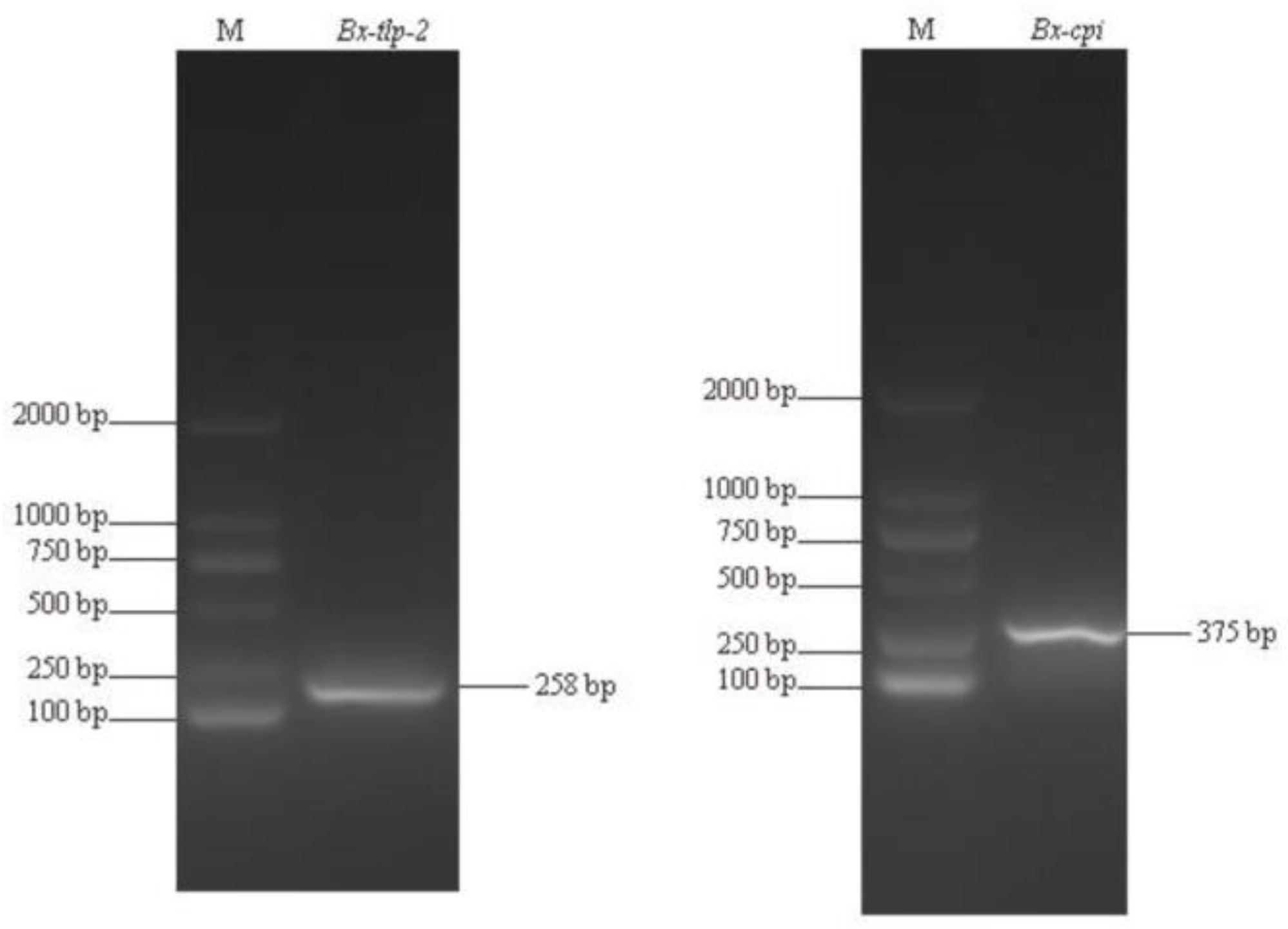


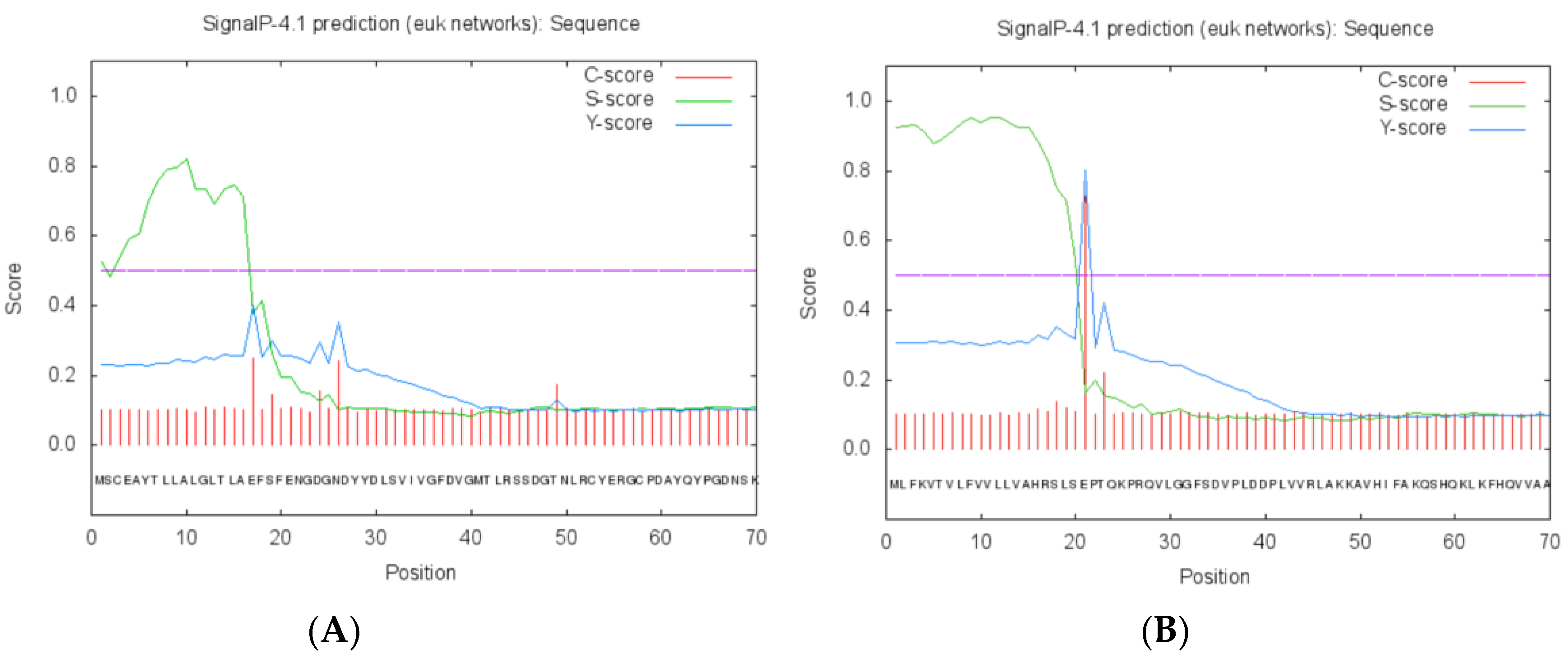
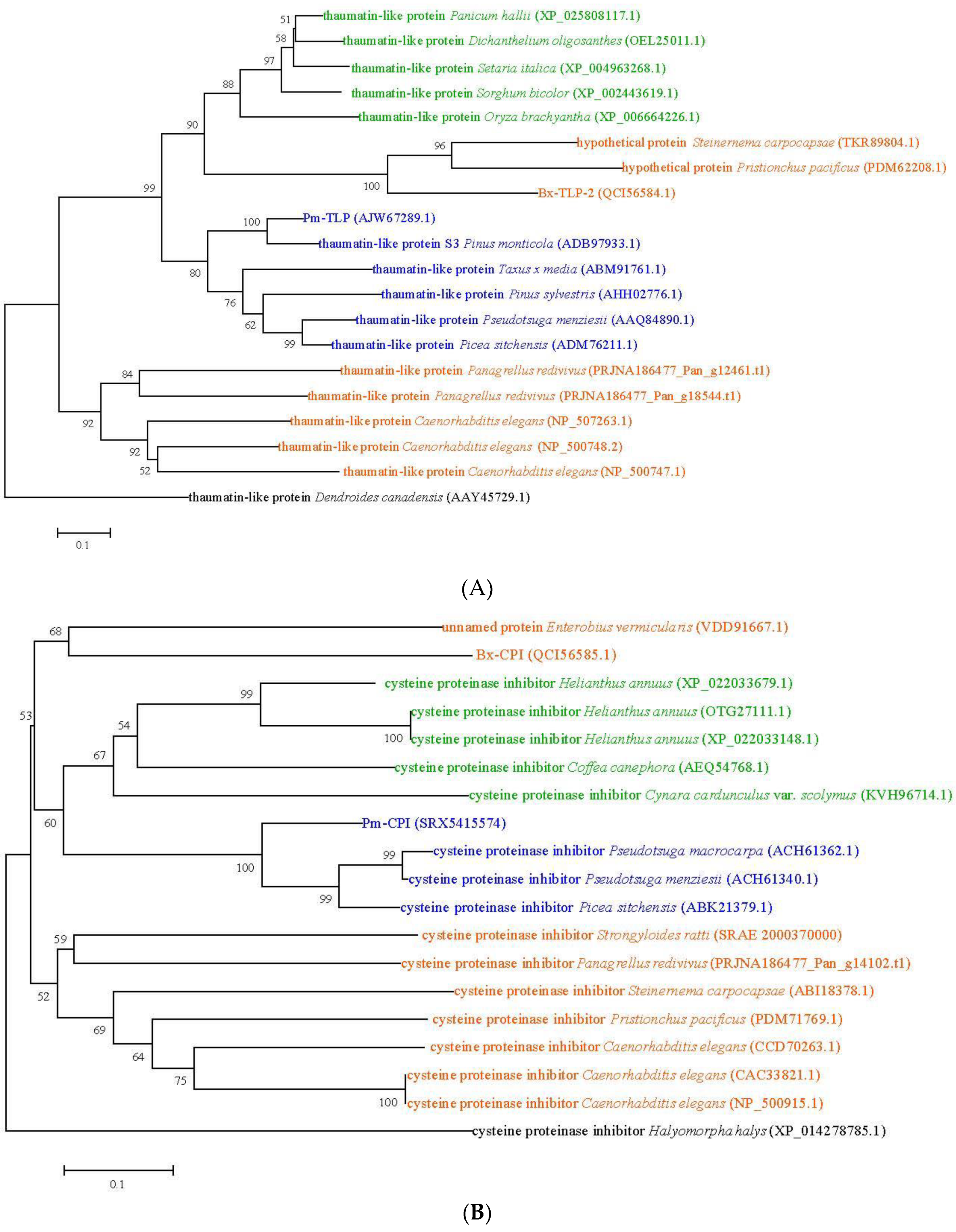

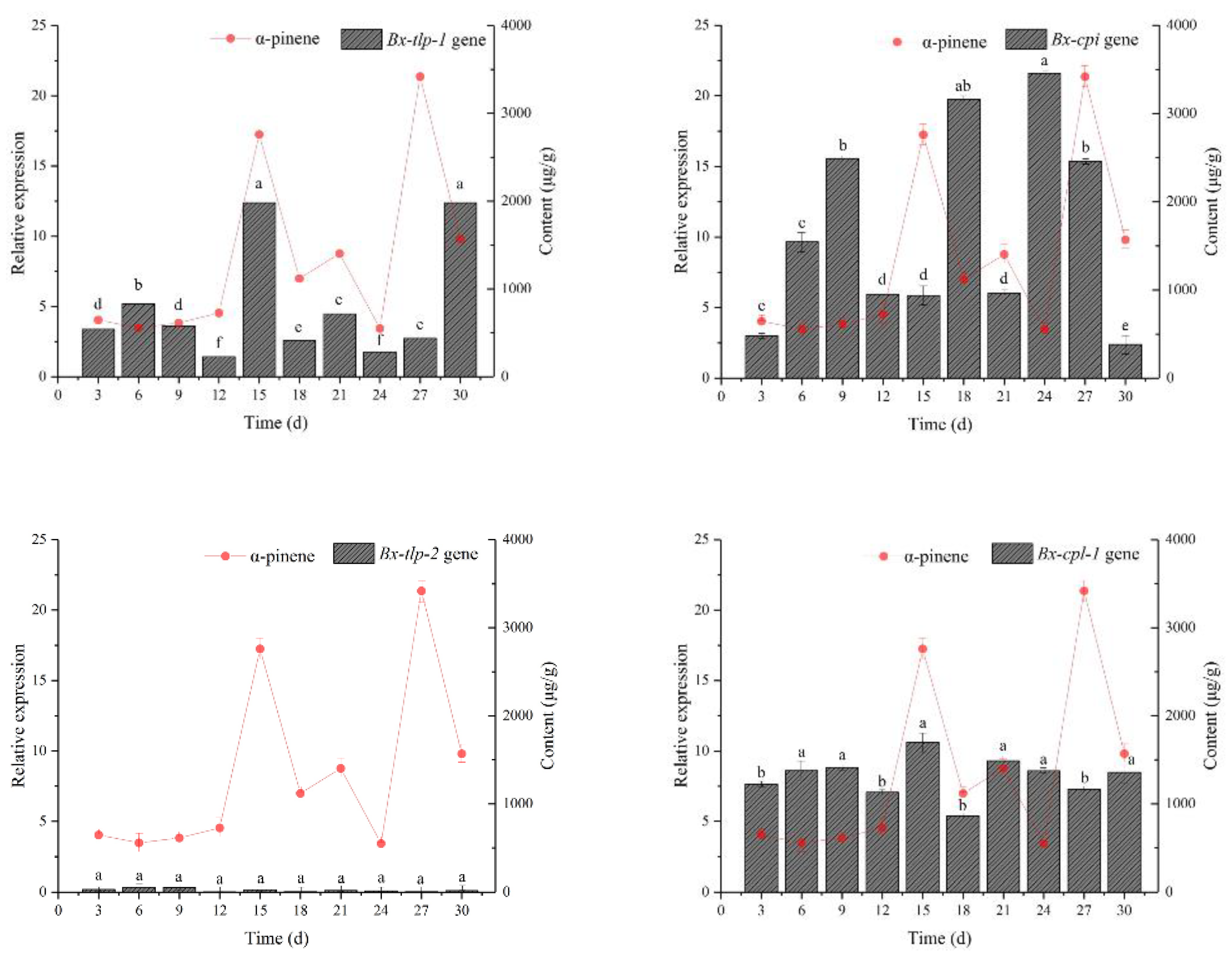
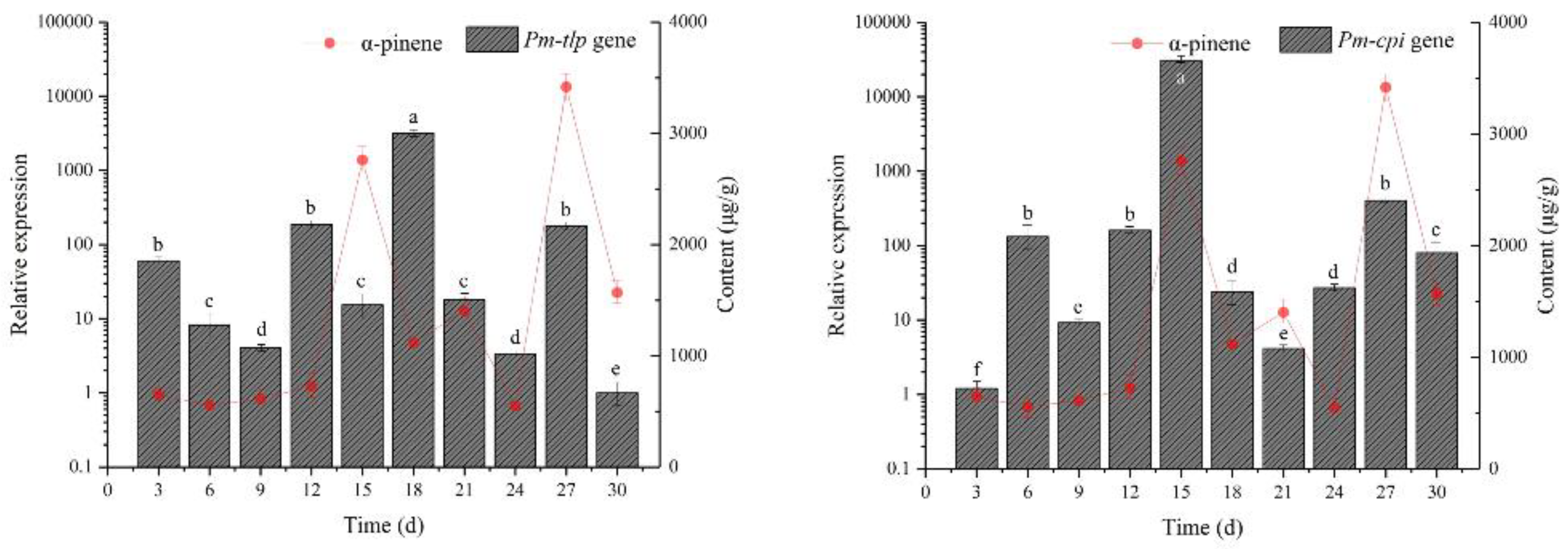
| Amino acids | Number | Percentage | Amino Acids | Number | Percentage | Amino Acids | Number | Percentage |
|---|---|---|---|---|---|---|---|---|
| Ala (A) | 4 | 4.7% | Gly (G) | 11 | 12.9% | Phe (F) | 5 | 5.9% |
| Arg (R) | 4 | 4.7% | His (H) | 1 | 1.2% | Pro (P) | 2 | 2.4% |
| Asn (N) | 4 | 4.7% | Ile (I) | 1 | 1.2% | Ser (S) | 6 | 7.1% |
| Asp (D) | 8 | 9.4% | Leu (L) | 9 | 10.6% | Thr (T) | 7 | 8.2% |
| Gln (Q) | 1 | 1.2% | Lys (K) | 1 | 1.2% | Tyr (Y) | 7 | 8.2% |
| Glu (Q) | 4 | 4.7% | Met (M) | 2 | 2.4% | Val (V) | 4 | 4.7% |
| Cys (C) | 4 | 4.7% |
| Amino acids | Number | Percentage | Amino Acids | Number | Percentage | Amino Acids | Number | Percentage |
|---|---|---|---|---|---|---|---|---|
| Ala (A) | 10 | 8.1% | Gly (G) | 4 | 3.2% | Phe (F) | 7 | 5.6% |
| Arg (R) | 4 | 3.2% | His (H) | 7 | 5.6% | Pro (P) | 5 | 4.0% |
| Asn (N) | 2 | 1.6% | Ile (I) | 5 | 4.0% | Ser (S) | 4 | 3.2% |
| Asp (D) | 3 | 2.4% | Leu (L) | 13 | 10.5% | Thr (T) | 3 | 2.4% |
| Gln (Q) | 14 | 11.3% | Lys (K) | 18 | 14.5% | Val (V) | 22 | 17.7% |
| Glu (Q) | 2 | 1.6% | Met (M) | 1 | 0.8% |
© 2020 by the authors. Licensee MDPI, Basel, Switzerland. This article is an open access article distributed under the terms and conditions of the Creative Commons Attribution (CC BY) license (http://creativecommons.org/licenses/by/4.0/).
Share and Cite
Meng, F.; Li, Y.; Liu, Z.; Wang, X.; Feng, Y.; Zhang, W.; Zhang, X. Potential Molecular Mimicry Proteins Responsive to α-pinene in Bursaphelenchus xylophilus. Int. J. Mol. Sci. 2020, 21, 982. https://doi.org/10.3390/ijms21030982
Meng F, Li Y, Liu Z, Wang X, Feng Y, Zhang W, Zhang X. Potential Molecular Mimicry Proteins Responsive to α-pinene in Bursaphelenchus xylophilus. International Journal of Molecular Sciences. 2020; 21(3):982. https://doi.org/10.3390/ijms21030982
Chicago/Turabian StyleMeng, Fanli, Yongxia Li, Zhenkai Liu, Xuan Wang, Yuqian Feng, Wei Zhang, and Xingyao Zhang. 2020. "Potential Molecular Mimicry Proteins Responsive to α-pinene in Bursaphelenchus xylophilus" International Journal of Molecular Sciences 21, no. 3: 982. https://doi.org/10.3390/ijms21030982
APA StyleMeng, F., Li, Y., Liu, Z., Wang, X., Feng, Y., Zhang, W., & Zhang, X. (2020). Potential Molecular Mimicry Proteins Responsive to α-pinene in Bursaphelenchus xylophilus. International Journal of Molecular Sciences, 21(3), 982. https://doi.org/10.3390/ijms21030982





